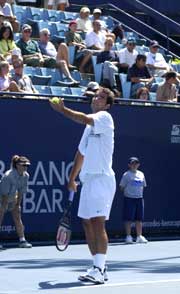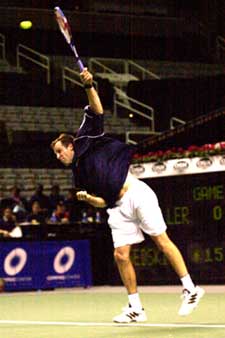<% ns_puts [mkm_getnavbar] %>

The Myth of the Toss
by John Yandell
Still Photos by J Gregory Swendsen
Page 2 |
Toss Height
Some of the greatest servers in tennis history have also had the highest
tosses. As the animations shows, Pete has an amazingly high toss. Precise
measurements will have to wait until Advanced Tennis has the chance to do
multi-camera quantitative filming, but for the purposes of an estimate, we
can say it drops at least 18Ē and possibly as much as 2 feet.
Rusedskiís toss is much lower, as the animation also shows, but it still
drops substantially. We can estimate this drop to be at least 8 to 12
inches or
possibly a little more.
The point of this analysis is not to say player should try to
copy an exact toss height from another player. The point is the toss
height determines the interval of the service motion and the amount of time
you have in turn determines your rhythm.
The average player needs to experiment with the height of the toss to find
an interval that allows him to develop a smooth, relaxed rhythm. This will
depend on the individual ability of the player, and also the complexity of
his biomechanical motion.
Want to see more high speed video of the serves of top players as well as other strokes? Click here for info on Advanced Tennis high speed digital videos. |
The height should be sufficient so that the motion is complete, with a full
racquet drop and full extension at contact. It should be relaxed, smooth,
and feel comfortably rhythmic, so this timing and feeling can be
duplicated naturally without conscious effort or extra muscle from
delivery to delivery.
Of course the toss can be too high as well. The toss should not be so high
that the player develops any hitches or pauses in the swing pattern, so
that he appears to be lagging at any point, waiting for the toss to drop
into position.
The right toss height, timing, and rhythm is something that can only be
developed through trial and error for the individual player.
Tossing Motion
Now for the second part of the myth of the toss, the tossing motion and
the actual path of the ball.
There is a famous apocryphal story that Jack Kramer practiced his toss by
placing a handkerchief on the court in front of his front foot, letting
his toss drop until he could hit the handkerchief 100 times in a row.



Due to his more extreme turn, Peteís tossing arm is parallel to the
baseline at the time of release.
Maybe thatís how Kramer practiced, but thatís not actually where he tossed
the ball when he played! (Check out Jackís real toss in the library in Ed
Atkinsonís piece on the Golden Age of Serve and Volley).
Itís not where any top server in the modern game tosses either.
As noted above, the shoulder turn is an important key to good serving,
something shared to a greater or lesser degree by top players. Since the
arm is attached to the shoulder, when the shoulders turn sideways, so does
the arm. The more turn in the motion, the more sideways the arm.
If the tossing arm stays in front, extending forward and straight outward, it
is impossible to make more than a very limited turn. This is why this myth
is so destructive.
A former top 10 player and top junior coach, who will remain nameless,
told me how he was taught to keep his arm in front and extend straight out
when he tossed. Only half joking, he told me he would be phoning in
coaching tips from his retirement home in Hawaii if he had only understood
how to turn his shoulders in his serving motion.
|
When a player turns, his arm will naturally point at least somewhat to the side, and from this position, the only possible path for the toss to reach the contact point is in the shape of an arc. If the ball really traveled straight up and down, players would have to reach to the side with a much lower contact point that would be 2 to 3 feet away from of their bodies!
The amount of shoulder turn, and therefore the exact position of the tossing arm, varies from player to player. Rusedski has one of the more limited turns. But his tossing arm is still pointing to the sideline at about a 45 degree angle at the time of release. Peteís turn goes further and so does his tossing arm. At the time of his ball release, itís 90 degrees to the sideline and actually parallel to the baseline.
This is why the path of the toss has to be an arc. To reach the contact zone, the ball has to travel back toward the player. The contact point occurs somewhere along this arced flight. Left undisturbed, this arced toss would actually land on the opposite side of the playerís body.
Because his turn is less extreme, the shape of this arc is also less
extreme for Greg compared to Pete. This is also related to the different
contact points for the two players. Rusedskiís contact point is further to
his side. He therefore intercepts the toss further away from his body
(more to his left), so that the contact is above or slightly to the side
of his hitting shoulder.
Peteís ball travels further along the arc, back closer to his torso since
his contact zone is closer to his body, somewhere between his shoulder and
the edge of his head.
Again, at this point in our research, attempting to quantify the exact distance the ball travels on the tossing arc is a matter of estimation. For Pete, the movement between the release of the ball and the contact point is probably about 2 1/2 to 3 feet. For Rusedski, it may be more like 1 Ĺ to 2 feet.
 |
 |
Your exact contact point and the arc of your toss will depend on your individual technical style, somewhere between the extremes of these two great servers. |
|
(These differing contact points in large part account for the different patterns of spin. More on this later and a quantitative analysis of the relative weight of the serve of both players.)
As with the tossing height, each player has to develop a tossing arc that
is comfortable and fits his individual technical style. Start by
physically establishing your contact point is in relation to your torso.
Actually stand on the court in serving position and model your contact
point with your arm and racquet.
The exact position will depend, on the nature of your delivery and whether you try to generate more topspin or slice. But itís a good bet it will fall somewhere between the extremes of Sampras and Rusedski.
Next model your body turn and the actual position of your tossing arm at the moment you release the ball. From this point, visualize the ball traveling on an arc to the contact point. Remember, in all cases this point should be out over the baseline and into the court.
As with most technical issues in the strokes, the only way to assess how
close you are to your models is to video yourself. Thatís where
ProStrokes
Gallery is an invaluable resource. Whoever your model, Pete, Rusedski,
Invanisevic, Rafter, McEnroe, etc, go there and compare your own tossing
motion and rhythm to the best players in the world. It takes work, sure,
but at least now youíre free from two tossing myths that may have been
holding you back for years.
Last Updated 4/1/02. To contact us, please email to: webmaster@tennisone.com
TennisONE is a registered trademark of TennisONE and SportsWeb ONE; Copyright 1995. All rights reserved.

